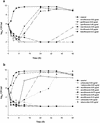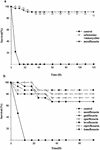In vitro and in vivo activities of newer fluoroquinolones against Vibrio vulnificus
- PMID: 12384368
- PMCID: PMC128723
- DOI: 10.1128/AAC.46.11.3580-3584.2002
In vitro and in vivo activities of newer fluoroquinolones against Vibrio vulnificus
Abstract
The MICs of six fluoroquinolones as well as minocycline and cefotaxime for 46 clinical isolates of Vibrio vulnificus were determined by the agar dilution method. All the drugs tested had good activities against all isolates, with the MICs at which 90% of the isolates tested were inhibited (MIC(90)s) by five of the fluoroquinolones ranging between 0.03 and 0.06 micro g/ml. The MIC(90) of lomefloxacin, on the other hand, was 0.12 micro g/ml. Time-kill studies were conducted with these agents and a clinical strain of V. vulnificus, VV5823. When approximately 5 x 10(5) CFU of V. vulnificus/ml was incubated with any one of the above-mentioned six fluoroquinolones at concentrations of two times the MIC, there was an inhibitory effect on V. vulnificus that persisted for more than 48 h with no noted regrowth. The efficacies of the fluoroquinolones were further evaluated in vivo in the mouse model of experimental V. vulnificus infection and compared to the efficacy of a combination therapy using cefotaxime plus minocycline. With an inoculum of 1.5 x 10(7) CFU, 28 (87.5%) of 32 mice in the cefotaxime-minocycline-treated group survived and 29 (91%) of the 32 mice in the moxifloxacin-treated group survived while none of the 32 mice in the control group did. With an inoculum of 3.5 x 10(7) CFU, the difference in survival rates among groups of 15 mice treated with levofloxacin (13 of 15), moxifloxacin (10 of 15), gatifloxacin (10 of 15), sparfloxacin (11 of 15), ciprofloxacin (12 of 15), or lomefloxacin (10 of 15) was not statistically significant while none of the 15 mice treated with saline survived. We concluded that the newer fluoroquinolones as single agents are as effective as the cefotaxime-minocycline combination in inhibiting V. vulnificus both in vitro and in vivo.
Figures


Similar articles
-
In vitro and in vivo antibacterial activity of tigecycline against Vibrio vulnificus.J Microbiol Immunol Infect. 2018 Feb;51(1):76-81. doi: 10.1016/j.jmii.2016.04.009. Epub 2016 May 13. J Microbiol Immunol Infect. 2018. PMID: 27260781
-
In vitro and in vivo activities of fluoroquinolones against Aeromonas hydrophila.Antimicrob Agents Chemother. 2003 Jul;47(7):2217-22. doi: 10.1128/AAC.47.7.2217-2222.2003. Antimicrob Agents Chemother. 2003. PMID: 12821471 Free PMC article.
-
In vitro synergism between cefotaxime and minocycline against Vibrio vulnificus.Antimicrob Agents Chemother. 1997 Oct;41(10):2214-7. doi: 10.1128/AAC.41.10.2214. Antimicrob Agents Chemother. 1997. PMID: 9333050 Free PMC article.
-
Minocycline and cefotaxime in the treatment of experimental murine Vibrio vulnificus infection.Antimicrob Agents Chemother. 1998 Jun;42(6):1319-22. doi: 10.1128/AAC.42.6.1319. Antimicrob Agents Chemother. 1998. PMID: 9624467 Free PMC article.
-
Vibrio vulnificus infection: clinical manifestations, pathogenesis, and antimicrobial therapy.J Microbiol Immunol Infect. 2003 Jun;36(2):81-8. J Microbiol Immunol Infect. 2003. PMID: 12886957 Review.
Cited by
-
Antimicrobial Effects of Minocycline, Tigecycline, Ciprofloxacin, and Levofloxacin against Elizabethkingia anophelis Using In Vitro Time-Kill Assays and In Vivo Zebrafish Animal Models.Antibiotics (Basel). 2021 Mar 10;10(3):285. doi: 10.3390/antibiotics10030285. Antibiotics (Basel). 2021. PMID: 33801839 Free PMC article.
-
Predictors of mortality in skin and soft-tissue infections caused by Vibrio vulnificus.World J Surg. 2010 Jul;34(7):1669-75. doi: 10.1007/s00268-010-0455-y. World J Surg. 2010. PMID: 20151130
-
Vibrio vulnificus in Taiwan.Emerg Infect Dis. 2004 Aug;10(8):1363-8. doi: 10.3201/eid1008.040047. Emerg Infect Dis. 2004. PMID: 15496235 Free PMC article. Review.
-
Vibrio vulnificus infection: a persistent threat to public health.Korean J Intern Med. 2018 Nov;33(6):1070-1078. doi: 10.3904/kjim.2018.159. Epub 2018 Jun 15. Korean J Intern Med. 2018. PMID: 29898575 Free PMC article. Review.
-
Evolution of resistance to fluoroquinolones by dengue virus serotype 4 provides insight into mechanism of action and consequences for viral fitness.Virology. 2021 Jan 2;552:94-106. doi: 10.1016/j.virol.2020.09.004. Epub 2020 Oct 1. Virology. 2021. PMID: 33120225 Free PMC article.
References
-
- Blake, P. A., M. H. Merson, R. E. Weaver, D. G. Hollis, and P. C. Heublein. 1979. Disease caused by a marine Vibrio: clinical characteristics and epidemiology. N. Engl. J. Med. 300:1-5. - PubMed
-
- Bonner, J. R., A. S. Coker, C. R. Berryman, and H. M. Pollock. 1983. Spectrum of vibrio infections in a gulf coast community. Ann. Intern. Med. 99:464-469. - PubMed
-
- Bowdre, J. H., J. H. Hull, and D. M. Cocchetto. 1983. Antibiotic efficacy against Vibrio vulnificus in the mouse: superiority of tetracycline. J. Pharmacol. Exp. Ther. 225:595-598. - PubMed
-
- Chuang, Y. C., C. Young, and C. W. Chen. 1989. Vibrio vulnificus infection. Scand. J. Infect. Dis. 21:721-726. - PubMed
-
- Chuang, Y. C., C. Y. Yuan, C. Y. Liu, C. K. Lan, and A. H. M. Huang. 1992. Vibrio vulnificus infection in Taiwan: report of 28 cases and review of clinical manifestations and treatment. Clin. Infect. Dis. 15:271-276. - PubMed
Publication types
MeSH terms
Substances
LinkOut - more resources
Full Text Sources

